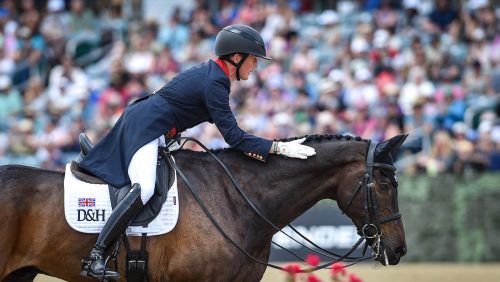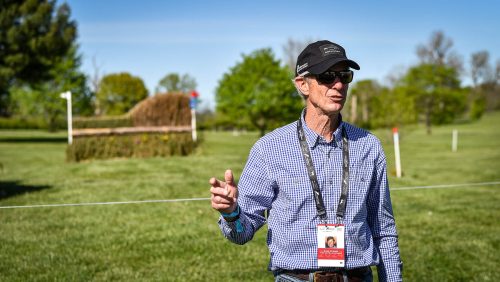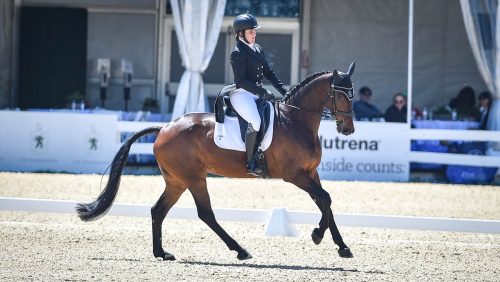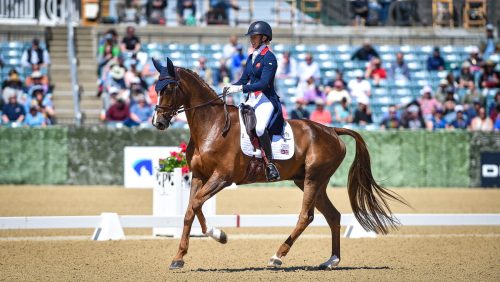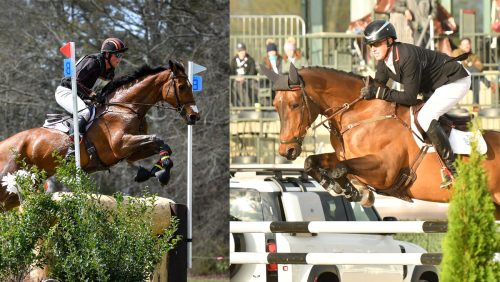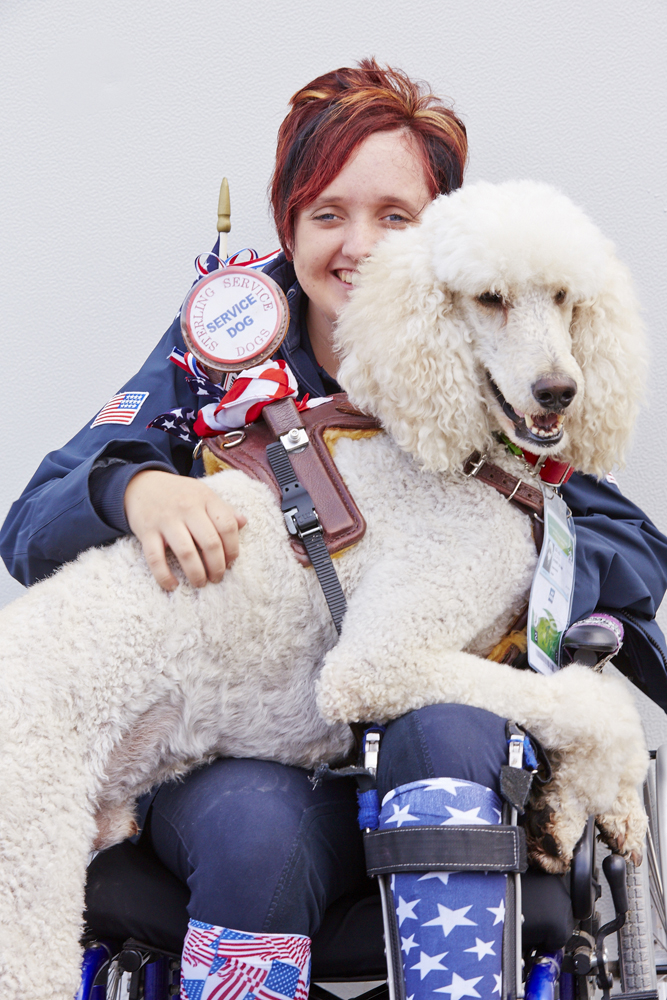 |
| Sydney Collier and Journey. Photo by FEI/Liz Gregg |
There were a lot of famous four-legged creatures at the Alltech FEI World Equestrian Games in Normandy, France, but surprisingly one of those quadraped stars was canine, not equine.
Journey, U.S. para-dressage rider Sydney Collier’s service dog, was a big hit with competitors, press and spectators alike when he became the first ever dog to receive an accreditation badge with access to the World Games venues in Normandy, France.
“It was funny because around every corner there would be someone else with a camera, so he had his own little paparazzi,” said Collier. “He liked being the center of attention!”
Journey goes everywhere with 16-year-old Collier, who has a rare birth defect called Wyburn Mason Syndrome, which severely limits her mobility, vision, and balance. So when the Collier family was having problems getting the Standard Poodle past the security guards of the World Games stadium on the first day of competition, show officials came up with a solution. Journey was issued his very own badge that he proudly wore around his neck to pose for pictures with his new fans.
“It’s crazy because about 170,000 humans got credentialed this year but only one dog!” said Collier. “It’s pretty great for him because now he’s paving a path for so many other service animals.”
Journey, 3, was bred and specially trained by Sterling Service Dogs (Mich.), to assist with Collier’s needs. The pair has been together for two years and Sydney considers him her best friend.
“It was quite the process finding someone who would train a dog specially to me because mobility needs are very individualized; the dogs take a lot more training than [seeing eye] dogs,” said Collier.
“The list of things that he does is super long!” she continued. “He basically acts like my cane to help me walk; if I fall he’ll go find my mom [Anna Collier] and help me get up; he can take things to my mom for me; opens and closes doors; and turns on and off lights. He can even do laundry!”
Sydney was diagnosed with Wyburn Mason Syndrome when she was 7 years old. The condition prohibits blood vessels from forming correctly deep within the brain and behind the retina. The “tumors” prevent her veins and arteries from separating, causing high blood flow in the brain and placing Sydney at risk of a fatal bleed.
ADVERTISEMENT
The disease, which causes headaches, seizures and problems with balance and vision, is incredibly rare. Researchers know very little about how to treat it, so Sydney and her family traveled to Stanford Medical Center (Calif.), from their home in Ann Arbor, Mich., to participate in an experimental treatment after she was diagnosed.
When a cycle of radiation proved ineffective, Sydney underwent her first brain surgery at age 11. The surgery caused her to have a stroke, and she lost the ability to walk and the use of her left arm. The stroke and several mini-strokes in later years also caused Sydney, already blind in her right eye, to lose most of the vision in her left eye.
Bound to a wheelchair for months, the horse-crazy girl was determined to re-learn to walk with the goal of getting back in the saddle. Now, about 20 surgeries and countless hours of rehab later, she is still largely unable to use the left side of her body but walks with the help of a leg brace and Journey’s harness, only using a wheelchair for long distances.
“There were really, really hard days in rehab when I thought maybe I can’t do this; maybe I won’t be able to walk again,” said Sydney. “It was really the thought of getting back onto a horse that got me through it.”
Not Giving Up
An aspiring eventer before her diagnosis, Sydney got back in the saddle as soon as she regained the ability to walk and found new hope for her riding career when she went to watch the 2010 World Equestrian Games, the year para-dressage was introduced to the competition.
“I honestly didn’t know much about [para-dressage] then, but when I was watching those riders I saw a lot of me in them,” said Sydney. “It truly inspired me that, in spite of my physical challenges, I didn’t have to give up on my goals.”
In that moment watching top riders, both able-bodied and para-equestrians, compete on an international stage, Sydney’s new para-dressage dream came alive.
She began with local and national shows, and soon she was traveling across the country to compete in top shows. She and Anna rent a house in Millbrook, N.Y., where they live part-time so that Sydney can train with Wes Dunham out of his Woodstock Stables (N.Y.). She even started her own foundation, Syd’s ParaQuest, to help inspire young, disabled riders with her story.
“It’s hard to put into words how much horses have done for me,” said Sydney. “They’re the best form of occupational and physical therapy because I’m just up there having fun!”
ADVERTISEMENT
But riding with limited mobility and eyesight has its challenges.
“It takes a lot of experimenting and figuring out what works for you,” said Sydney. “I ride one-handed and I have to use different aids. And because [eyesight affects] my depth perception, it actually shifts where I’m looking. If I’m trying to go right on the centerline, I actually have to look 5 meters to the left in order for it to be anywhere near centerline. So it takes a lot for [Dunham] to adjust his training and let me know the right markers for me to be looking at.”
In four short years, the bubbly teenager went from watching the sport of para-dressage for the first time at the World Games to riding in the competition herself. Her own horse, Wentworth, incurred a minor injury before the selection trials and was unable to make the trip to France, so Sydney borrowed the ride on Victoria Dugan’s Willi Wesley for her international debut.
“[Willi] is special because he has an able-bodied owner and rider, so when I started training with him he readjusted to my body so quickly,” said Sydney. “It’s actually amazing to see how horses like Willi can block out the cues that they don’t need to pay attention to and really focus on the ones they do need to focus on.”
The pair rode to ninth place individually in the Grade 1b division, receiving a score of 68.10 percent.
“The competition was incredible; I couldn’t be happier,” said Sydney. “Looking at what Willi and I have done in such a short amount of time really brings a smile to my face. There have been a lot of bumps along the road, but I’ve done my best to roll with them and keep on track. Being only 16 at the [World Games] was really exciting for me, and I hope it’s the only the beginning of a long career in para-dressage.”
“I’ve always seen it as no matter what happens to me physically, as long as I can share the bond that I have with horses, I’ll be happy,” she added.
Sydney plans on competing with Wentworth in Europe this year and is now looking toward a new goal: qualifying for the 2015 Paralympics. As for Journey, he’ll continue to travel to shows, pose for pictures with his new fans and stand beside his best friend as she continues on her para-quest.







